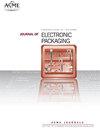Reliability of State-of-health of the Flexible Li-ion Batteries Under Various Flexing Conditions and Calendar Aging
IF 2.3
4区 工程技术
Q3 ENGINEERING, ELECTRICAL & ELECTRONIC
引用次数: 0
Abstract
Due to the necessity for flexibility without compromising the LIB's state of health (SOH), the reliability of Li-ion batteries (LIB) is a critical challenge for FHE devices. A thin form factor-based LIB with a thickness of less than 1mm is regarded as the candidate material to suit such demands since it can be folded, bent, and twisted with minimal performance loss. Furthermore, LIB has high specific power (W/Kg) and specific energy (Wh/Kg), as well as a smaller memory effect, making it more appealing for wearable applications. While much research has been done on the chemo-physical effects of repeated charging and discharging LIB, such as SEI development, material deterioration, and so on, but such impacts owing to repeated flexure LIB have not been much studied. The deterioration of the reliability of thin-flexible power sources was investigated in this work under twist, flexing, and flex-to-install to simulate stresses of daily motions of the human body by utilizing motion-control setups in a lab setting. Furthermore, an AI-based regression model has been developed to forecast the SOH of the battery based on many variables such as physical, atmospheric, and chemo-mechanical experimental circumstances that may be difficult to address by manpower. Based on the various variables and their interactions, the generated models are expected to be used to predict battery life and assess the acceleration factors between test circumstances and usage conditions for a range of test scenarios.柔性锂离子电池在不同弯曲条件和日历老化下的健康状态可靠性
由于在不影响LIB健康状态(SOH)的情况下需要灵活性,锂离子电池(LIB)的可靠性是FHE设备面临的关键挑战。厚度小于1mm的基于薄形状因子的LIB被认为是满足这些需求的候选材料,因为它可以折叠、弯曲和扭曲,性能损失最小。此外,LIB具有高比功率(W/Kg)和比能量(Wh/Kg),以及较小的记忆效应,使其对可穿戴应用更具吸引力。虽然已经对重复充放电LIB的化学物理效应进行了大量研究,如SEI的发展、材料的劣化等,但由于重复弯曲LIB而产生的这种影响尚未得到太多研究。在这项工作中,通过在实验室环境中使用运动控制装置,研究了薄柔性电源在扭曲、弯曲和弯曲安装下的可靠性恶化,以模拟人体日常运动的应力。此外,已经开发了一个基于人工智能的回归模型,以基于许多变量预测电池的SOH,如物理、大气和化学机械实验环境,这些变量可能难以由人力解决。基于各种变量及其相互作用,生成的模型预计将用于预测电池寿命,并评估一系列测试场景的测试环境和使用条件之间的加速因素。
本文章由计算机程序翻译,如有差异,请以英文原文为准。
求助全文
约1分钟内获得全文
求助全文
来源期刊

Journal of Electronic Packaging
工程技术-工程:电子与电气
CiteScore
4.90
自引率
6.20%
发文量
44
审稿时长
3 months
期刊介绍:
The Journal of Electronic Packaging publishes papers that use experimental and theoretical (analytical and computer-aided) methods, approaches, and techniques to address and solve various mechanical, materials, and reliability problems encountered in the analysis, design, manufacturing, testing, and operation of electronic and photonics components, devices, and systems.
Scope: Microsystems packaging; Systems integration; Flexible electronics; Materials with nano structures and in general small scale systems.
 求助内容:
求助内容: 应助结果提醒方式:
应助结果提醒方式:


